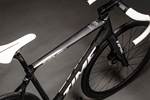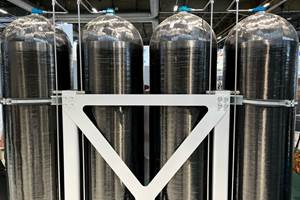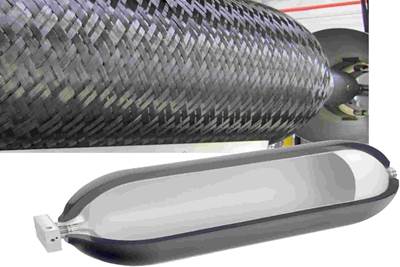KraussMaffei, AIM collaboration achieves HP-RTM carbon fiber wheel rims
KraussMaffei supported, coordinated and delivered compact production equipment tailored to design and process needs for high-quality automotive rims.
Together with KraussMaffei (Parsdorf, Germany), Taiwanese composite specialist Advanced International Multitech (AIM, Kaohsiung City) is expanding its portfolio to include high-pressure resin transfer molding (HP-RTM). In addition to golf clubs and bicycles, AIM is now producing high-quality carbon fiber rims for automotive wheels via this system.
In comparison to low-pressure processes, HP-RTM requires more complex dosing technology, but also delivers consistent, high-quality components with precise surface quality and shorter cycle times — the latter being particularly important in automotive.
AIM’s market share is 80% carbon fiber golf clubs (under different brand names). The company has also shown success in the bicycle market. For around 30 years, various composite technologies have been a part of the company’s standard repertoire. When AIM first ventured into the automotive sector, however, and placed an HP-RTM system in operation, the company wanted to get to better know the technology. This is where KraussMaffei’s know-how became advantageous.
“Fredrick Su, our sales partner at KraussMaffei, listened carefully, and then put together a package that we could use in an HP-RTM cell to recreate both high-pressure transfer molding as well as wet molding and compression RTM for small production series. We were really impressed by this,” says Tyson Hsaio, R&D manager of AIM.
A concrete project was soon to follow. Carbon fiber rims tend to occupy a niche in the automotive sector, yet are lucrative because they are in the high-price segment. According to KraussMaffei, a material mixture is common: A rim body made of carbon fiber-reinforced plastic (CFRP) to which the visually appealing aluminum wheel spider is bolted.
The entire production cell for the carbon rims measures just 16 × 12 meters, including the enclosure, and is therefore very compact.
These wheels are approximately 20-30% lighter than those made of pure aluminum and, at the same time, are around 20% stronger than aluminum rims. Sporty and ambitious drivers can accelerate faster thanks to the reduced weight and the unevenness of roads can be dampened by the suspension, making the driving experience more pleasant.
KraussMaffei project manager Thomas Eilhammer actively supported AIM and coordinated a comprehensive package consisting of an MX press (with a clamping force of 10,000 kilonewtons), the RimStar Compact 8/4 HP-RTM metering system, two robots for metering and handling (with different grippers) and a mold solution. “The system now has, at 16 × 12 meters, quite a compact design, and all its components are well tuned to one another,” says Eilhammer. “This, simply said, reflects our strength as a full-service provider.”
René Ring’s team at the plant in Georgsmarienhütte, Harderberg, was responsible for mold development. “We apply a master mold and use several mold packages for the different rim diameters. This gives the customer a lot of flexibility,” Ring says. The subsequent process is as follows:
- A carbon fiber preform, prepared by the customer, is placed over the inner core of the mold, and four sliders, which form the round outer contour of the rim, move simultaneously.
- The press closes and the epoxy matrix material is metered through a distribution star.
- After a curing time of approximately 15 minutes, the mold opens, the sliders open and an ejector ring presses the rim body — which has shrunk to the core (20 inches in diameter) — upwards. The mold is flexible, from 18-22 inches in diameter, and a rim width of 8-12 inches.
- Finishing takes place through a series of downstream processes.
KraussMaffei notes that the mold’s many moving parts made it a challenge to seal the complete system at high cavity pressure. Normally, the pressing force alone is sufficient to seal a mold, in which the horizontal sealing surface is located solely between the upper and lower parts of the mold. In the case of AIM’s rim project, however, the undercuts and C-shaped contours of the part, and the moving ejector ring, made demolding difficult.
The team came up with something special for the rim tool: The movable cylinders lock and unlock, ensuring a seal.
To retain the mold’s vacuum — and thus prevent low-viscosity material from escaping — the team strove to achieve the best possible manufacturing precision, and with it, a good design. In the final system, a locking force is generated by four barrels on the top of the master mold, and locking elements are mounted underneath, which move into recesses on the sliders and block them. With a mold temperature of 120-130°C, it became necessary to protect the pneumatic and electronic components with insulation boards.
The mold weighs a total of 4.9 tons. It was manufactured in 2023 in Harderberg, then prototyped in the KraussMaffei TechCenter in Munich, where it was optimized once again, and finally delivered with the complete system to the customer. Since the fundamental requirement of a rim is that it is round, Ring’s team is particularly proud of the fact that, “we achieved a concentricity precision of less than 2/100 millimeters.” Another achievement was successfully producing a good part with the first shot.
The carbon rim has already been exhibited at JEC World 2024, and Hsiao praises the collaboration. “It was important for us to have an experienced, full-service provider for HP-RTM at our side, who offered great proficiency in systems, processes and mold technology. This gave us the ability to concentrate on our role: the production of the carbon blanks. As a result, the cogs meshed, producing a perfect wheel.”
Related Content
Recycling hydrogen tanks to produce automotive structural components
Voith Composites and partners develop recycling solutions for hydrogen storage tanks and manufacturing methods to produce automotive parts from the recycled materials.
Read More“Structured air” TPS safeguards composite structures
Powered by an 85% air/15% pure polyimide aerogel, Blueshift’s novel material system protects structures during transient thermal events from -200°C to beyond 2400°C for rockets, battery boxes and more.
Read MoreMcLaren celebrates 10 years of the McLaren P1 hybrid hypercar
Lightweight carbon fiber construction, Formula 1-inspired aerodynamics and high-performance hybrid powertrain technologies hallmark this hybrid vehicle, serve as a springboard for new race cars.
Read MoreCryo-compressed hydrogen, the best solution for storage and refueling stations?
Cryomotive’s CRYOGAS solution claims the highest storage density, lowest refueling cost and widest operating range without H2 losses while using one-fifth the carbon fiber required in compressed gas tanks.
Read MoreRead Next
HP-RTM as a means to reduce hydrogen tank packaging space and cost
BBG Gmbh & Co. KG has developed molds for producers of type IV CFRP tanks, integrating automation and sensors for faster, cheaper production of adjustable-length hydrogen storage cylinders.
Read MoreCarbon fiber wheels added to Range Rover Sport SV Edition Two
Carbon Revolution’s 23-inch composite wheel option contributes to ~168 pounds in weight savings, minimizing unsprung mass while improving handling acceleration and ride quality.
Read MoreTime Bicycles to modernize composite bicycle manufacturing
With the aid of KraussMaffei, Clemson University and SC Fraunhofer USA Alliance, Time anticipates a transition to HP-RTM for more efficient carbon fiber bike frame manufacture, plus a new facility in South Carolina.
Read More





























